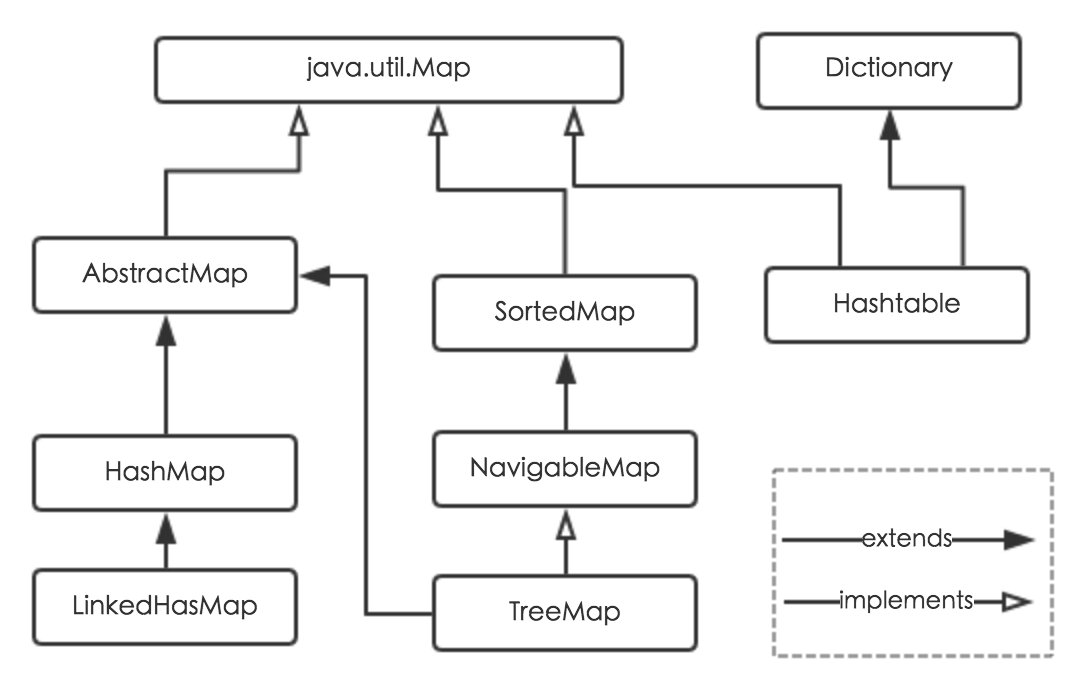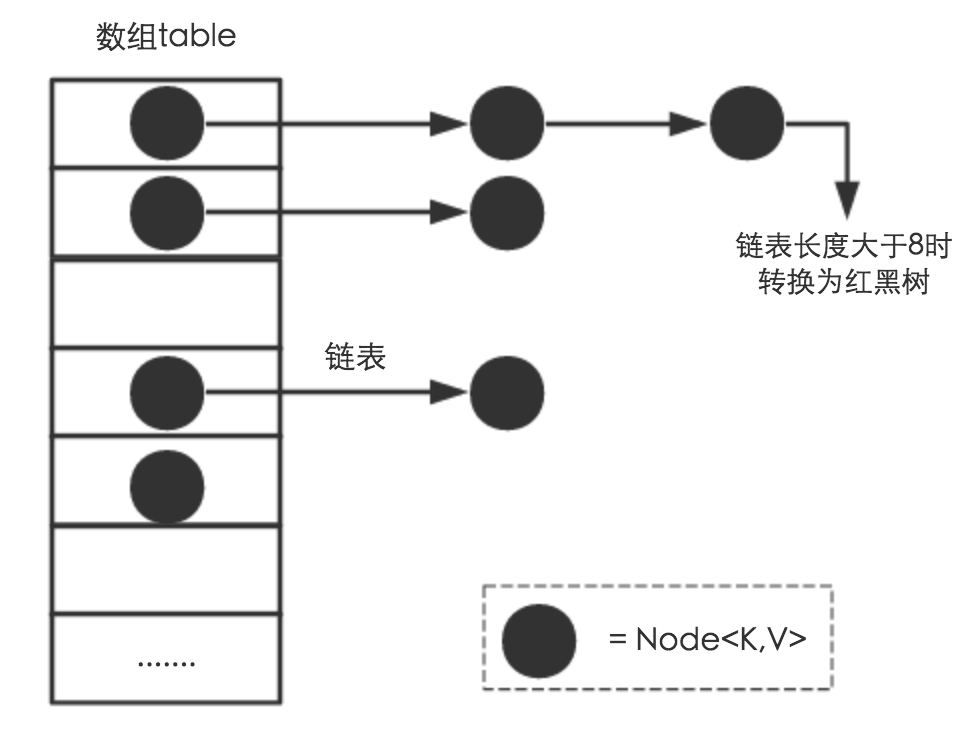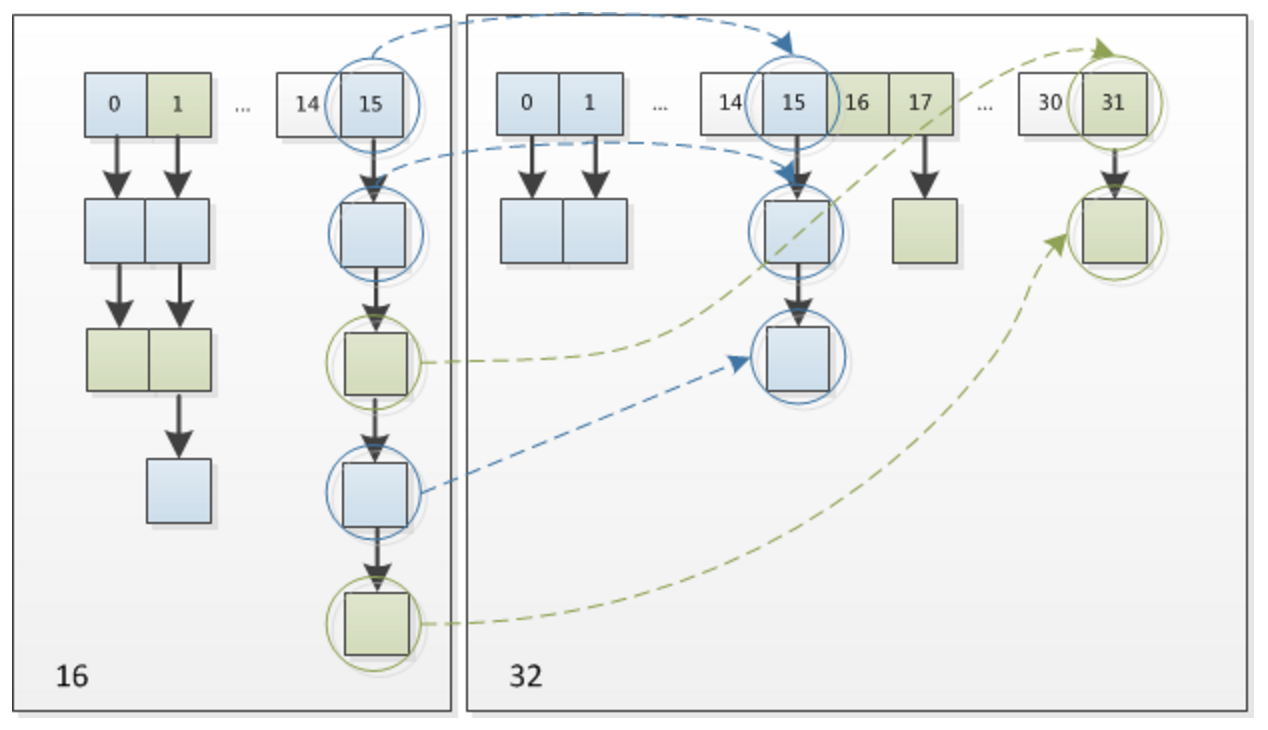JDK1.8源码阅读系列之四:HashMap (原创)
本篇随笔主要描述的是我阅读 HashMap 源码期间的对于 HashMap 的一些实现上的个人理解,用于个人备忘,有不对的地方,请指出~
接下来会从以下几个方面介绍 HashMap 源码相关知识:
1、HashMap 存储结构
2、HashMap 各常量、成员变量作用
3、HashMap 几种构造方法
4、HashMap put 及其相关方法
5、HashMap get 及其相关方法
6、HashMap remove 及其相关方法(暂未理解透彻)
7、HashMap 扩容方法 resize()
介绍方法时会包含方法实现相关细节。
先来看一下 HashMap 的继承图:

HashMap 根据键的 hashCode 值存储数据,大多数情况下可以直接定位到它的值,因而具有很快的访问速度,但遍历顺序却是不确定的。 HashMap 最多只允许一条记录的键为 null ,允许多条记录的值为 null 。HashMap 非线程安全,即任一时刻可以有多个线程同时写 HashMap,可能会导致数据的不一致。如果需要满足线程安全,可以用 Collections的synchronizedMap 方法使 HashMap 具有线程安全的能力,或者使用ConcurrentHashMap 。
一、HashMap 存储结构
HashMap是数组+链表+红黑树(JDK1.8增加了红黑树部分)实现的,如下图所示:

源码中具体实现如下:
- // Node<K,V> 类用来实现数组及链表的数据结构
- static class Node<K,V> implements Map.Entry<K,V> {
- final int hash; //保存节点的 hash 值
- final K key; //保存节点的 key 值
- V value; //保存节点的 value 值
- Node<K,V> next; //指向链表结构下的当前节点的 next 节点,红黑树 TreeNode 节点中也有用到
- Node(int hash, K key, V value, Node<K,V> next) {
- this.hash = hash;
- this.key = key;
- this.value = value;
- this.next = next;
- }
- public final K getKey() { }
- public final V getValue() { }
- public final String toString() { }
- public final int hashCode() {
- }
- public final V setValue(V newValue) {
- }
- public final boolean equals(Object o) {
- }
- }
- public class LinkedHashMap<K,V> {
- static class Entry<K,V> extends HashMap.Node<K,V> {
- Entry<K,V> before, after;
- Entry(int hash, K key, V value, Node<K,V> next) {
- super(hash, key, value, next);
- }
- }
- }
- // TreeNode<K,V> 继承 LinkedHashMap.Entry<K,V>,用来实现红黑树相关的存储结构
- static final class TreeNode<K,V> extends LinkedHashMap.Entry<K,V> {
- TreeNode<K,V> parent; // 存储当前节点的父节点
- TreeNode<K,V> left; //存储当前节点的左孩子
- TreeNode<K,V> right; //存储当前节点的右孩子
- TreeNode<K,V> prev; // 存储当前节点的前一个节点
- boolean red; // 存储当前节点的颜色(红、黑)
- TreeNode(int hash, K key, V val, Node<K,V> next) {
- super(hash, key, val, next);
- }
- final TreeNode<K,V> root() {
- }
- static <K,V> void moveRootToFront(Node<K,V>[] tab, TreeNode<K,V> root) {
- }
- final TreeNode<K,V> find(int h, Object k, Class<?> kc) {
- }
- final void treeify(Node<K,V>[] tab) {
- }
- final Node<K,V> untreeify(HashMap<K,V> map) {
- }
- final TreeNode<K,V> putTreeVal(HashMap<K,V> map, Node<K,V>[] tab,
- int h, K k, V v) {
- }
- final void removeTreeNode(HashMap<K,V> map, Node<K,V>[] tab,
- boolean movable) {
- }
- final void split(HashMap<K,V> map, Node<K,V>[] tab, int index, int bit) {
- }
- /* ------------------------------------------------------------ */
- // Red-black tree methods, all adapted from CLR
- // 红黑树相关操作
- static <K,V> TreeNode<K,V> rotateLeft(TreeNode<K,V> root,
- TreeNode<K,V> p) {
- }
- static <K,V> TreeNode<K,V> rotateRight(TreeNode<K,V> root,
- TreeNode<K,V> p) {
- }
- static <K,V> TreeNode<K,V> balanceInsertion(TreeNode<K,V> root,
- TreeNode<K,V> x) {
- }
- static <K,V> TreeNode<K,V> balanceDeletion(TreeNode<K,V> root,
- TreeNode<K,V> x) {
- }
- static <K,V> boolean checkInvariants(TreeNode<K,V> t) {
- }
- }
二、HashMap 各常量、成员变量作用
- //创建 HashMap 时未指定初始容量情况下的默认容量
- static final int DEFAULT_INITIAL_CAPACITY = 1 << 4;
- //HashMap 的最大容量
- static final int MAXIMUM_CAPACITY = 1 << 30;
- //HashMap 默认的装载因子,当 HashMap 中元素数量超过 容量*装载因子 时,进行 resize() 操作
- static final float DEFAULT_LOAD_FACTOR = 0.75f;
- //用来确定何时将解决 hash 冲突的链表转变为红黑树
- static final int TREEIFY_THRESHOLD = 8;
- // 用来确定何时将解决 hash 冲突的红黑树转变为链表
- static final int UNTREEIFY_THRESHOLD = 6;
- /* 当需要将解决 hash 冲突的链表转变为红黑树时,需要判断下此时数组容量,若是由于数组容量太小(小于 MIN_TREEIFY_CAPACITY )导致的 hash 冲突太多,则不进行链表转变为红黑树操作,转为利用 resize() 函数对 hashMap 扩容 */
- static final int MIN_TREEIFY_CAPACITY = 64;
- //保存Node<K,V>节点的数组
- transient Node<K,V>[] table;
- //由 hashMap 中 Node<K,V> 节点构成的 set
- transient Set<Map.Entry<K,V>> entrySet;
- //记录 hashMap 当前存储的元素的数量
- transient int size;
- //记录 hashMap 发生结构性变化的次数(注意 value 的覆盖不属于结构性变化)
- transient int modCount;
- //threshold的值应等于 table.length * loadFactor, size 超过这个值时进行 resize()扩容
- int threshold;
- //记录 hashMap 装载因子
- final float loadFactor;
三、HashMap 几种构造方法
- //构造方法1,指定初始容量及装载因子
- public HashMap(int initialCapacity, float loadFactor) {
- if (initialCapacity < 0)
- throw new IllegalArgumentException("Illegal initial capacity: " +
- initialCapacity);
- if (initialCapacity > MAXIMUM_CAPACITY)
- initialCapacity = MAXIMUM_CAPACITY;
- if (loadFactor <= 0 || Float.isNaN(loadFactor))
- throw new IllegalArgumentException("Illegal load factor: " +
- loadFactor);
- this.loadFactor = loadFactor;
- /* tableSizeFor(initialCapacity) 方法返回的值是最接近 initialCapacity 的2的幂,若指定初始容量为9,则实际 hashMap 容量为16*/
- //注意此种方法创建的 hashMap 初始容量的值存在 threshold 中
- this.threshold = tableSizeFor(initialCapacity);
- }
- //tableSizeFor(initialCapacity) 方法返回的值是最接近 initialCapacity 的2的幂
- static final int tableSizeFor(int cap) {
- int n = cap - 1;
- n |= n >>> 1;// >>> 代表无符号右移
- n |= n >>> 2;
- n |= n >>> 4;
- n |= n >>> 8;
- n |= n >>> 16;
- return (n < 0) ? 1 : (n >= MAXIMUM_CAPACITY) ? MAXIMUM_CAPACITY : n + 1;
- }
- //构造方法2,仅指定初始容量,装载因子的值采用默认的 0.75
- public HashMap(int initialCapacity) {
- this(initialCapacity, DEFAULT_LOAD_FACTOR);
- }
- //构造方法3,所有参数均采用默认值
- public HashMap() {
- this.loadFactor = DEFAULT_LOAD_FACTOR; // all other fields defaulted
- }
四、HashMap put 及其相关方法
这部分我觉得是 hashMap 中比较重要的代码,介绍如下:
- //指定节点 key,value,向 hashMap 中插入节点
- public V put(K key, V value) {
- //注意待插入节点 hash 值的计算,调用了 hash(key) 函数
- //实际调用 putVal()进行节点的插入
- return putVal(hash(key), key, value, false, true);
- }
- static final int hash(Object key) {
- int h;
- /*key 的 hash 值的计算是通过hashCode()的高16位异或低16位实现的:(h = k.hashCode()) ^ (h >>> 16),主要是从速度、功效、质量来考虑的,这么做可以在数组table的length比较小的时候,也能保证考虑到高低Bit都参与到Hash的计算中,同时不会有太大的开销*/
- return (key == null) ? 0 : (h = key.hashCode()) ^ (h >>> 16);
- }
- public void putAll(Map<? extends K, ? extends V> m) {
- putMapEntries(m, true);
- }
- /*把Map<? extends K, ? extends V> m 中的元素插入到 hashMap 中,若 evict 为 false,代表是在创建 hashMap 时调用了这个函数,例如利用上述构造函数3创建 hashMap;若 evict 为true,代表是在创建 hashMap 后才调用这个函数,例如上述的 putAll 函数。*/
- final void putMapEntries(Map<? extends K, ? extends V> m, boolean evict) {
- int s = m.size();
- if (s > 0) {
- /*如果是在创建 hashMap 时调用的这个函数则 table 一定为空*/
- if (table == null) {
- //根据待插入的map 的 size 计算要创建的 hashMap 的容量。
- float ft = ((float)s / loadFactor) + 1.0F;
- int t = ((ft < (float)MAXIMUM_CAPACITY) ?
- (int)ft : MAXIMUM_CAPACITY);
- //把要创建的 hashMap 的容量存在 threshold 中
- if (t > threshold)
- threshold = tableSizeFor(t);
- }
- //判断待插入的 map 的 size,若 size 大于 threshold,则先进行 resize()
- else if (s > threshold)
- resize();
- for (Map.Entry<? extends K, ? extends V> e : m.entrySet()) {
- K key = e.getKey();
- V value = e.getValue();
- //实际也是调用 putVal 函数进行元素的插入
- putVal(hash(key), key, value, false, evict);
- }
- }
- }
- final V putVal(int hash, K key, V value, boolean onlyIfAbsent,
- boolean evict) {
- Node<K,V>[] tab; Node<K,V> p; int n, i;
- if ((tab = table) == null || (n = tab.length) == 0)
- n = (tab = resize()).length;
- /*根据 hash 值确定节点在数组中的插入位置,若此位置没有元素则进行插入,注意确定插入位置所用的计算方法为 (n - 1) & hash,由于 n 一定是2的幂次,这个操作相当于
- hash % n */
- if ((p = tab[i = (n - 1) & hash]) == null)
- tab[i] = newNode(hash, key, value, null);
- else {//说明待插入位置存在元素
- Node<K,V> e; K k;
- //比较原来元素与待插入元素的 hash 值和 key 值
- if (p.hash == hash &&
- ((k = p.key) == key || (key != null && key.equals(k))))
- e = p;
- //若原来元素是红黑树节点,调用红黑树的插入方法:putTreeVal
- else if (p instanceof TreeNode)
- e = ((TreeNode<K,V>)p).putTreeVal(this, tab, hash, key, value);
- else {//证明原来的元素是链表的头结点,从此节点开始向后寻找合适插入位置
- for (int binCount = 0; ; ++binCount) {
- if ((e = p.next) == null) {
- //找到插入位置后,新建节点插入
- p.next = newNode(hash, key, value, null);
- //若链表上节点超过TREEIFY_THRESHOLD - 1,将链表变为红黑树
- if (binCount >= TREEIFY_THRESHOLD - 1) // -1 for 1st
- treeifyBin(tab, hash);
- break;
- }
- if (e.hash == hash &&
- ((k = e.key) == key || (key != null && key.equals(k))))
- break;
- p = e;
- }
- }//end else
- if (e != null) { // 待插入元素在 hashMap 中已存在
- V oldValue = e.value;
- if (!onlyIfAbsent || oldValue == null)
- e.value = value;
- afterNodeAccess(e);
- return oldValue;
- }
- }//end else
- ++modCount;
- if (++size > threshold)
- resize();
- afterNodeInsertion(evict);
- return null;
- }//end putval
- /*读懂这个函数要注意理解 hash 冲突发生的几种情况
- 1、两节点 key 值相同(hash值一定相同),导致冲突
- 2、两节点 key 值不同,由于 hash 函数的局限性导致hash 值相同,冲突
- 3、两节点 key 值不同,hash 值不同,但 hash 值对数组长度取模后相同,冲突
- */
- final TreeNode<K,V> putTreeVal(HashMap<K,V> map, Node<K,V>[] tab,
- int h, K k, V v) {
- Class<?> kc = null;
- boolean searched = false;
- TreeNode<K,V> root = (parent != null) ? root() : this;
- //从根节点开始查找合适的插入位置(与二叉搜索树查找过程相同)
- for (TreeNode<K,V> p = root;;) {
- int dir, ph; K pk;
- if ((ph = p.hash) > h)
- dir = -1; // dir小于0,接下来查找当前节点左孩子
- else if (ph < h)
- dir = 1; // dir大于0,接下来查找当前节点右孩子
- else if ((pk = p.key) == k || (pk != null && k.equals(pk)))
- //进入这个else if 代表 hash 值相同,key 相同
- return p;
- /*要进入下面这个else if,代表有以下几个含义:
- 1、当前节点与待插入节点 key 不同, hash 值相同
- 2、k是不可比较的,即k并未实现 comparable<K> 接口
(若 k 实现了comparable<K> 接口,comparableClassFor(k)返回的是k的 class,而不是 null)- 或者 compareComparables(kc, k, pk) 返回值为 0
(pk 为空 或者 按照 k.compareTo(pk) 返回值为0,
返回值为0可能是由于 k的compareTo 方法实现不当引起的,compareTo 判定相等,而上个 else if 中 equals 判定不等)*/- else if ((kc == null &&
- (kc = comparableClassFor(k)) == null) ||
- (dir = compareComparables(kc, k, pk)) == 0) {
- //在以当前节点为根的整个树上搜索是否存在待插入节点(只会搜索一次)
- if (!searched) {
- TreeNode<K,V> q, ch;
- searched = true;
- if (((ch = p.left) != null &&
- (q = ch.find(h, k, kc)) != null) ||
- ((ch = p.right) != null &&
- (q = ch.find(h, k, kc)) != null))
- //若树中存在待插入节点,直接返回
- return q;
- }
- // 既然k是不可比较的,那我自己指定一个比较方式
- dir = tieBreakOrder(k, pk);
- }//end else if
- TreeNode<K,V> xp = p;
- if ((p = (dir <= 0) ? p.left : p.right) == null) {
- //找到了待插入的位置,xp 为待插入节点的父节点
- //注意TreeNode节点中既存在树状关系,也存在链式关系,并且是双端链表
- Node<K,V> xpn = xp.next;
- TreeNode<K,V> x = map.newTreeNode(h, k, v, xpn);
- if (dir <= 0)
- xp.left = x;
- else
- xp.right = x;
- xp.next = x;
- x.parent = x.prev = xp;
- if (xpn != null)
- ((TreeNode<K,V>)xpn).prev = x;
- //插入节点后进行二叉树的平衡操作
- moveRootToFront(tab, balanceInsertion(root, x));
- return null;
- }
- }//end for
- }//end putTreeVal
- static int tieBreakOrder(Object a, Object b) {
- int d;
- //System.identityHashCode()实际是利用对象 a,b 的内存地址进行比较
- if (a == null || b == null ||
- (d = a.getClass().getName().
- compareTo(b.getClass().getName())) == 0)
- d = (System.identityHashCode(a) <= System.identityHashCode(b) ?
- -1 : 1);
- return d;
- }
五、HashMap get 及其相关方法
- public V get(Object key) {
- Node<K,V> e;
- //实际上是根据输入节点的 hash 值和 key 值利用getNode 方法进行查找
- return (e = getNode(hash(key), key)) == null ? null : e.value;
- }
- final Node<K,V> getNode(int hash, Object key) {
- Node<K,V>[] tab; Node<K,V> first, e; int n; K k;
- if ((tab = table) != null && (n = tab.length) > 0 &&
- (first = tab[(n - 1) & hash]) != null) {
- if (first.hash == hash && // always check first node
- ((k = first.key) == key || (key != null && key.equals(k))))
- return first;
- if ((e = first.next) != null) {
- if (first instanceof TreeNode)
- //若定位到的节点是 TreeNode 节点,则在树中进行查找
- return ((TreeNode<K,V>)first).getTreeNode(hash, key);
- do {//否则在链表中进行查找
- if (e.hash == hash &&
- ((k = e.key) == key || (key != null && key.equals(k))))
- return e;
- } while ((e = e.next) != null);
- }
- }
- return null;
- }
- final TreeNode<K,V> getTreeNode(int h, Object k) {
- //从根节点开始,调用 find 方法进行查找
- return ((parent != null) ? root() : this).find(h, k, null);
- }
- final TreeNode<K,V> find(int h, Object k, Class<?> kc) {
- TreeNode<K,V> p = this;
- do {
- int ph, dir; K pk;
- TreeNode<K,V> pl = p.left, pr = p.right, q;
- //首先进行hash 值的比较,若不同令当前节点变为它的左孩子或者右孩子
- if ((ph = p.hash) > h)
- p = pl;
- else if (ph < h)
- p = pr;
- //hash 值相同,进行 key 值的比较
- else if ((pk = p.key) == k || (k != null && k.equals(pk)))
- return p;
- else if (pl == null)
- p = pr;
- else if (pr == null)
- p = pl;
- //执行到这儿,意味着hash 值相同,key 值不同
- //若k 是可比较的并且k.compareTo(pk) 返回结果不为0可进入下面elseif
- else if ((kc != null ||
- (kc = comparableClassFor(k)) != null) &&
- (dir = compareComparables(kc, k, pk)) != 0)
- p = (dir < 0) ? pl : pr;
- /*若 k 是不可比较的 或者 k.compareTo(pk) 返回结果为0则在整棵树中进行查找,先找右子树,右子树没有再找左子树*/
- else if ((q = pr.find(h, k, kc)) != null)
- return q;
- else
- p = pl;
- } while (p != null);
- return null;
- }
七、HashMap 扩容方法 resize()
resize() 方法中比较重要的是链表和红黑树的 rehash 操作,先来说下 rehash 的实现原理:
我们在扩容的时候,一般是把长度扩为原来2倍,所以,元素的位置要么是在原位置,要么是在原位置再移动2次幂的位置。看下图可以明白这句话的意思,n为table的长度,图(a)表示扩容前的key1和key2两种key确定索引位置的示例,图(b)表示扩容后key1和key2两种key确定索引位置的示例,其中hash1是key1对应的哈希与高位运算结果。

元素在重新计算hash之后,因为n变为2倍,那么n-1的mask范围在高位多1bit(红色),因此新的index就会发生这样的变化:

因此,我们在扩充HashMap的时候,只需要看看原来的hash值新增的那个bit是1还是0就好了,是0的话索引没变,是1的话索引变成“原索引+oldCap”,可以看看下图为16扩充为32的resize示意图:

这个算法很巧妙,既省去了重新计算hash值的时间,而且同时,由于新增的1bit是0还是1可以认为是随机的,因此resize的过程,均匀的把之前的冲突的节点分散到新的槽中了。
具体源码介绍:
- final Node<K,V>[] resize() {
- Node<K,V>[] oldTab = table;
- int oldCap = (oldTab == null) ? 0 : oldTab.length;
- int oldThr = threshold;
- int newCap, newThr = 0;
- /*
- 1、resize()函数在size > threshold时被调用。
- oldCap大于 0 代表原来的 table 表非空, oldCap 为原表的大小,
- oldThr(threshold) 为 oldCap × load_factor
- */
- if (oldCap > 0) {
- if (oldCap >= MAXIMUM_CAPACITY) {
- threshold = Integer.MAX_VALUE;
- return oldTab;
- }
- else if ((newCap = oldCap << 1) < MAXIMUM_CAPACITY &&
- oldCap >= DEFAULT_INITIAL_CAPACITY)
- newThr = oldThr << 1; // double threshold
- }
- /*
- 2、resize()函数在table为空被调用。
- oldCap 小于等于 0 且 oldThr 大于0,代表用户创建了一个 HashMap,但是使用的构造函数为
- HashMap(int initialCapacity, float loadFactor) 或 HashMap(int initialCapacity)
- 或 HashMap(Map<? extends K, ? extends V> m),导致 oldTab 为 null,oldCap 为0,
- oldThr 为用户指定的 HashMap的初始容量。
- */
- else if (oldThr > 0) // initial capacity was placed in threshold
- newCap = oldThr;
- /*
- 3、resize()函数在table为空被调用。
- oldCap 小于等于 0 且 oldThr 等于0,用户调用 HashMap()构造函数创建的 HashMap,所有值均采用默认值,
- oldTab(Table)表为空,oldCap为0,oldThr等于0,
- */
- else { // zero initial threshold signifies using defaults
- newCap = DEFAULT_INITIAL_CAPACITY;
- newThr = (int)(DEFAULT_LOAD_FACTOR * DEFAULT_INITIAL_CAPACITY);
- }
- if (newThr == 0) {
- float ft = (float)newCap * loadFactor;
- newThr = (newCap < MAXIMUM_CAPACITY && ft < (float)MAXIMUM_CAPACITY ?
- (int)ft : Integer.MAX_VALUE);
- }
- threshold = newThr;
- Node<K,V>[] newTab = (Node<K,V>[])new Node[newCap];
- table = newTab;
- if (oldTab != null) {
- //把 oldTab 中的节点 reHash 到 newTab 中去
- for (int j = 0; j < oldCap; ++j) {
- Node<K,V> e;
- if ((e = oldTab[j]) != null) {
- oldTab[j] = null;
- //若节点是单个节点,直接在 newTab 中进行重定位
- if (e.next == null)
- newTab[e.hash & (newCap - 1)] = e;
- //若节点是 TreeNode 节点,要进行 红黑树的 rehash 操作
- else if (e instanceof TreeNode)
- ((TreeNode<K,V>)e).split(this, newTab, j, oldCap);
- //若是链表,进行链表的 rehash 操作
- else { // preserve order
- Node<K,V> loHead = null, loTail = null;
- Node<K,V> hiHead = null, hiTail = null;
- Node<K,V> next;
- do {
- next = e.next;
- //根据算法 e.hash & oldCap 判断节点位置 rehash 后是否发生改变
- if ((e.hash & oldCap) == 0) {
- if (loTail == null)
- loHead = e;
- else
- loTail.next = e;
- loTail = e;
- }
- else {
- if (hiTail == null)
- hiHead = e;
- else
- hiTail.next = e;
- hiTail = e;
- }
- } while ((e = next) != null);
- if (loTail != null) {
- loTail.next = null;
- newTab[j] = loHead;
- }
- if (hiTail != null) {
- hiTail.next = null;
- // rehash 后节点新的位置一定为原来基础上加上 oldCap
- newTab[j + oldCap] = hiHead;
- }
- }
- }
- }
- }
- return newTab;
- }
- //这个函数的功能是对红黑树进行 rehash 操作
- final void split(HashMap<K,V> map, Node<K,V>[] tab, int index, int bit) {
- TreeNode<K,V> b = this;
- // Relink into lo and hi lists, preserving order
- TreeNode<K,V> loHead = null, loTail = null;
- TreeNode<K,V> hiHead = null, hiTail = null;
- int lc = 0, hc = 0;
- //由于 TreeNode 节点之间存在双端链表的关系,可以利用链表关系进行 rehash
- for (TreeNode<K,V> e = b, next; e != null; e = next) {
- next = (TreeNode<K,V>)e.next;
- e.next = null;
- if ((e.hash & bit) == 0) {
- if ((e.prev = loTail) == null)
- loHead = e;
- else
- loTail.next = e;
- loTail = e;
- ++lc;
- }
- else {
- if ((e.prev = hiTail) == null)
- hiHead = e;
- else
- hiTail.next = e;
- hiTail = e;
- ++hc;
- }
- }
- //rehash 操作之后注意对根据链表长度进行 untreeify 或 treeify 操作
- if (loHead != null) {
- if (lc <= UNTREEIFY_THRESHOLD)
- tab[index] = loHead.untreeify(map);
- else {
- tab[index] = loHead;
- if (hiHead != null) // (else is already treeified)
- loHead.treeify(tab);
- }
- }
- if (hiHead != null) {
- if (hc <= UNTREEIFY_THRESHOLD)
- tab[index + bit] = hiHead.untreeify(map);
- else {
- tab[index + bit] = hiHead;
- if (loHead != null)
- hiHead.treeify(tab);
- }
- }//end if
- }//end split
关于 HashMap 源码阅读的相关知识就先介绍到这里,有一些地方我还没有理解透彻(例如红黑树的插入节点之后的平衡操作,删除节点操作),后期会继续补充。
如果你觉得本篇文章对你有用的话,请顺手点一下推荐,让更多的人看到,感谢!
参考文章:http://tech.meituan.com/java-hashmap.html
JDK1.8源码阅读系列之四:HashMap (原创)的更多相关文章
- JDK1.8源码阅读系列之三:Vector
本篇随笔主要描述的是我阅读 Vector 源码期间的对于 Vector 的一些实现上的个人理解,用于个人备忘,有不对的地方,请指出- 先来看一下 Vector 的继承图: 可以看出,Vector 的直 ...
- JDK1.8源码阅读系列之一:ArrayList
本篇随笔主要描述的是我阅读 ArrayList 源码期间的对于 ArrayList 的一些实现上的个人理解,有不对的地方,请指出- 先来看一下 ArrayList 的继承图: 由图可以看出,Array ...
- JDK1.8源码阅读系列之二:LinkedList
本篇随笔主要描述的是我阅读 LinkedList 源码期间的对于 LinkedList 的一些实现上的个人理解,有不对的地方,请指出- 先来看一下 LinkedList 的继承图: 由于 Abstra ...
- 【JDK1.8】 Java小白的源码学习系列:HashMap
目录 Java小白的源码学习系列:HashMap 官方文档解读 基本数据结构 基本源码解读 基本成员变量 构造器 巧妙的tableSizeFor put方法 巧妙的hash方法 JDK1.8的putV ...
- 源码阅读系列:EventBus
title: 源码阅读系列:EventBus date: 2016-12-22 16:16:47 tags: 源码阅读 --- EventBus 是人们在日常开发中经常会用到的开源库,即使是不直接用的 ...
- 【Dubbo源码阅读系列】之远程服务调用(上)
今天打算来讲一讲 Dubbo 服务远程调用.笔者在开始看 Dubbo 远程服务相关源码的时候,看的有点迷糊.后来慢慢明白 Dubbo 远程服务的调用的本质就是动态代理模式的一种实现.本地消费者无须知道 ...
- 【Dubbo源码阅读系列】服务暴露之本地暴露
在上一篇文章中我们介绍 Dubbo 自定义标签解析相关内容,其中我们自定义的 XML 标签 <dubbo:service /> 会被解析为 ServiceBean 对象(传送门:Dubbo ...
- JDK1.8源码阅读笔记(1)Object类
JDK1.8源码阅读笔记(1)Object类 Object 类属于 java.lang 包,此包下的所有类在使⽤时⽆需⼿动导⼊,系统会在程序编译期间⾃动 导⼊.Object 类是所有类的基类,当⼀ ...
- Spring源码阅读系列总结
最近一段时间,粗略的查看了一下Spring源码,对Spring的两大核心和Spring的组件有了更深入的了解.同时在学习Spring源码时,得了解一些设计模式,不然阅读源码还是有一定难度的,所以一些重 ...
随机推荐
- 《SpringMVC数据绑定入门》笔记
基本类型 最好使用封装类型 简单多数据&多层级对象 简单多数据 单个对象,直接使用属性名=值即可 多层级对象 属性.属性=值即可 同属性多对象 WebDataBinder只在当前类中生效,不是 ...
- X-006 FriendlyARM tiny4412 u-boot移植之Debug串口用起来
<<<<<<<<<<<<<<<<<<<<<<<<< ...
- AFNetworking content type not support
ref:http://blog.csdn.net/nyh1006/article/details/25068255 1.错误信息:Error:Error Domain=AFNetworkingErro ...
- STM32 USB 问题汇总(转)
源:STM32 USB 问题汇总 汇总1:STM32的USB例程修改步骤,来自http://blog.csdn.net/cy757/archive/2010/01/01/5117610.aspx 以下 ...
- 2017 ZSTU寒假排位赛 #2
题目链接:https://vjudge.net/contest/147632#overview. A题,状态压缩一下然后暴力即可. B题,水题,略过. C题,有负数,前缀和不是单调的,因此不能用尺取法 ...
- make的参数
转载自 陈皓<跟我一起写 Makefile> 下面列举了所有GNU make 3.80版的参数定义.其它版本和产商的make大同小异,不过其它产商的make的具体参数还是请参考各自的产品文 ...
- cocos2d-x 跨平台usleep方法
#if (CC_TARGET_PLATFORM == CC_PLATFORM_WIN32) #define usleep(t) Sleep(t) #else #include <unistd.h ...
- 5)Javascript设计模式:extends模式
简单的方式 function Person() { this.name = 'person'; } Person.prototype.say = function() {}; function Chi ...
- ZOJ 1108 & HDU 1160 - FatMouse's Speed
题目大意:给你n只老鼠的体重w和速度s,让你找出最长的子序列使得w[i] < w[j] 且 s[i] > s[j] (i < j).求最长序列的长度并输出该序列. LIS(Longe ...
- java系列--过滤器
在web.xml配置过滤器:过滤器一定要放在所以Servlet前面 过滤器的生命周期: 过滤器的应用: 1.编码格式 2.权限验证 3.数据库关闭
